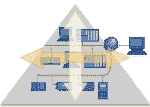|
By : Jim Pinto, Automation products must have Ethernet connectivity. The real question is whether to connect directly on Ethernet, or indirectly via one of the entrenched industrial networks. Ethernet alone does not guarantee that two devices can talk to each other. There must be compatibility at the application layers.
May, 2006
|
 Ethernet usage has increased in the automation environment, and the proliferation of Ethernet-ready products for device-level networks continues. For industrial networking, the big advantage is the ability to connect everything—from the plant floor to the corporate boardroom—on one network, providing access to data throughout the enterprise from anywhere around the world.
Ethernet usage has increased in the automation environment, and the proliferation of Ethernet-ready products for device-level networks continues. For industrial networking, the big advantage is the ability to connect everything—from the plant floor to the corporate boardroom—on one network, providing access to data throughout the enterprise from anywhere around the world.
The clear advantages have brought many automation world enhancements to Ethernet standards, especially in areas of determinism, speed and prioritization. There is no longer any reason why Ethernet cannot be used to build deterministic, open and inexpensive automation network solutions. The traditional industrial automation majors are clearly on the Ethernet bandwagon. For example, Rockwell Automation, Siemens and others claim that up to 70 percent to 80 percent of their automation products are Ethernet-enabled. Deterministic non-determinismWhen first adopted in the mid-1980s as the Institute of Electrical and Electronics Engineers’ IEEE 802.3 standard, Ethernet was considered unsuitable for automation, purportedly because it was (and it still is) “nondeterministic.” The fundamental characteristic of Ethernet networks at any speed is that the average delivery speed degrades in a non-linear way with loading. Device response times cannot be guaranteed because of data collisions and delays in retransmitting data.For most factory automation applications, 100 Mbps Ethernet is deterministic enough. Ethernet’s “nondeterminism” has been vastly reduced by advanced switching technologies that allow multiple devices simultaneously to transmit and receive data over multiple network loops. Ethernet switches can divide networks into virtual local area networks that segment devices into logical work groups. Ethernet switches also typically have a fast internal backbone, which helps eliminate collisions among data packets. Fast switches can quickly swap network lines, thereby responding very rapidly to anomalies such as missed communications, power failures and device failures. Adding some intelligence to the switch improves quality of service and adds queue management capabilities. By assigning a priority to time-sensitive data, intelligent Ethernet switches can elevate that traffic above lower-priority data. This ensures that high-priority traffic always traverses the network even if the network becomes congested. Switches also have capabilities that can classify, reclassify, police, mark and even drop incoming data packets as application priorities require. Operating speeds across even conventional wire cabling have increased from 10 megabits/second (Mbps) to 100 Mbps. Automatic switches that negotiate 10/100 Mbps are common, optimizing speed and service, as well as allowing a mix of 10 Mbps and 100 Mbps devices on the same network. The higher speed reduces the probability of data collisions and lost data, and delays are no longer an issue. For most factory automation applications, 100 Mbps Ethernet is deterministic enough. Today, 1 gigabit/second (Gbps) is available, and 10 Gbps is near. Gigabit Ethernet is primarily targeted for enterprise-wide backbone networks, and it is showing up in distributed control system backbones in the process industries. Clearly, automation and control products must have Ethernet connectivity. The real question is whether devices should be connected directly on Ethernet as nodes, or indirectly via one of the entrenched device networks. Ethernet alone does not guarantee that two devices can talk to each other. There must be compatibility at the application layers. To make this happen, a common data model is needed, that allows the porting of application-layer software from one platform to another. As the major industrial networks become more entrenched, it seems sensible to move forward with mixed systems. In my opinion, more and more users will take the step of an industrial Ethernet solution with minimal systems interface and direct connect to the input/output layer. 
|
Return to Index of all JimPinto Writings

 Return to JimPinto.com HomePage
Return to JimPinto.com HomePage
If you have ideas or suggestions to improve this site, contact: webmaster@jimpinto.com
Copyright 2003 : Jim Pinto, San Diego, CA, USA
